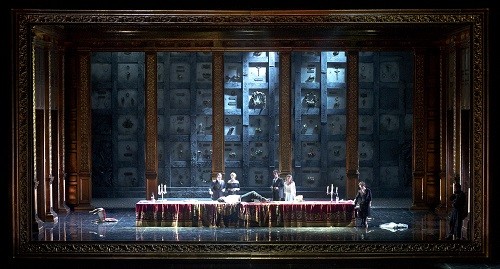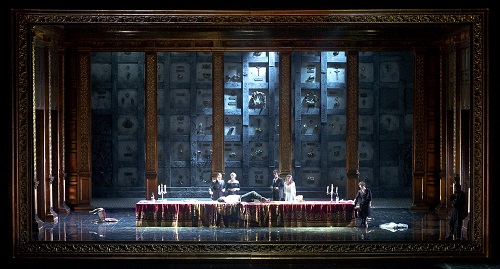 Argentina Mozart, Don Giovanni: Soloists, Chorus and Orchestra. Conductor: Marc Piollet, Teatro Colón, Buenos Aires. 12.4.2016. (JSJ)
Argentina Mozart, Don Giovanni: Soloists, Chorus and Orchestra. Conductor: Marc Piollet, Teatro Colón, Buenos Aires. 12.4.2016. (JSJ)

Production:
Director: Emilio Sagi
Sets: Daniel Bianco
Costumes: Renata Schussheim
Lighting: José Luis Fiorruccio
Chorus: Miguel Martínez
Cast:
Don Giovanni: Erwin Schrott / Homero Pérez Miranda
Doña Ana: Paula Almerares / Daniela Tabernig
Doña Elvira: María Bayo / Mónica Ferracani
Don Ottavio: Jonathan Boyd / Santiago Bürgi
Leporello: Simon Orfila / Lucas Debevec Mayer
Zerlina: Jaquelina Livieri / Marisú Pavón
Masetto: Mario De Salvo / Gustavo Feulien
Commendatore: Lucas Debevec Mayer / Emiliano Bulacios
Don Giovanni has been one of the more frequently performed operas in Buenos Aires in recent years. Indeed the last production at the Teatro Colón was a recently as 2010.
But the latest production of this classic buffa, which officially opened the Colón’s 2016 opera season, has been arguably the most eagerly awaited – and the reason, Erwin Schrott in the title role, which is one for which he has become particularly known. Nor did he disappoint. With his age, looks and physique, which are ideal for the role, coupled with his smooth, full delivery, his performance was memorable and for this reviewer at least, will be a yardstick that will surely be hard to match.
Alongside him, Simon Orfila, who debuted at the Colón as Dulcamara (L’elisir d’amore) this time last year, was an outstanding Leporello, firm voiced and with the right degree of servility but without the simpleness that is sometimes shown to bolster the humour. American tenor Jonathan Boyd was a rounded Don Ottavio, sympathetic and scholarly in his bearing.
Less satisfactory, however, were the leading ladies. Paula Almerares as Doña Ana, although acting well was uneven. María Bayo as Doña Elvira, although showing no diminishment of power, is not up to her former level vocally. She looked also, as she was made up, more like someone of Don Giovanni’s mother’s generation than a young lover, which gave an interesting twist to their respective tastes.
As the peasant Masetto and his new bride Zerlina, Mario De Salvo and especially Jaquelina Livieri gave noteworthy performances. So too did Lucas Debevec Mayer as Doña Ana’s father and the Comendatore – but unfortunately we saw all too little of him as in one of the more curious aspects of the production, there was no statue in the cemetery or at the final dinner – just an amplified voice from above. Indeed the cemetery itself consisted only of a ‘wall’ of tombs and when Leporello addressed the Comendatore it was offstage to the back.
So while the production was memorable for the singing, it was also – although for the wrong reasons – for the staging from director Emilio Sagi and scenographer Daniel Bianco. As if viewing a picture, it was contained within – but at times outside – a giant picture frame, along with an almost unchanging backdrop. Though this general setting wasn’t modern in appearance, the dress was – and perhaps most bizarre of all was the final scene with what appeared to be the breaking up of pieces of cake into crumbs on to Don Giovanni’s lifeless body atop the dining table.
Marc Piollet led the orchestra with energy and passion, and the chorus sung well, the last moments from the orchestra pit.
Jonathan Spencer Jones
